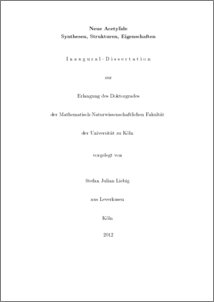Liebig, Stefan Julian
(2013).
Neue Acetylide. Synthesen, Strukturen, Eigenschaften.
PhD thesis, Universität zu Köln.

![[img]](https://kups.ub.uni-koeln.de/style/images/fileicons/application_pdf.png)  Preview |
|
PDF
Dissertation_Stefan_Liebig.pdf
- Published Version
Download (15MB)
|
Abstract
In Anlehnung an die Methoden zur Darstellung von gemischtkationischen Alkalimetallchalkogeniden des Typs AA’X (X = Oxid-, Sulfid-, Selenid-, Telluridion) konnte eine neue Syntheseroute für die gemischtkationischen Alkalimetallacetylide gefunden werden (X = Acetyliddianion). Mit diesem Verfahren waren die bislang unbekannten Verbindungen Cäsiumnatrium-, Cäsiumkalium-, Cäsiumrubidium- und Kaliumrubidiumacetylid zugänglich. Die orthorhombischen und tetragonalen Kristallstrukturen dieser Acetylide konnten anhand von Synchrotronpulverdiffraktogrammen mit Methoden wie dem charge flipping Algorithmus oder durch Vergleich mit bekannten Strukturen gelöst und mithilfe der Rietveldmethode verfeinert werden. Das temperaturabhängige strukturelle Verhalten der Verbindungen wurde anhand von DSC-Messungen untersucht und die Verbindungen Cäsiumnatriumacetylid, Cäsiumkaliumacetylid und Cäsiumrubidiumacetylid daraufhin mit in situ-Hochtemperatur-Synchrotrondiffraktionsdaten charakterisiert. Hierbei konnten verschiedene strukturelle Umwandlungen auf die thermisch angeregte Bewegung der Acetylidhantel zurückgeführt werden. Im Fall von Cäsiumnatriumacetylid wurde eine neuartige Fehlordnung in der Hochtemperaturphase diskutiert.
Die Ergebnisse wurden in einen gemeinsamen Kontext gefasst und mit den literaturbe- kannten Strukturen dieser Verbindungsklasse verglichen. Alle Strukturen wurden in die Struktursystematik der gemischtkationischen Alkalimetallchalkogenide eingeordnet und Gemeinsamkeiten und Unterschiede der Verbindungen beleuchtet. Des Weiteren wurde versucht, die Klassifizierung auf Grundlage von kationischen und anionischen Strukturmotiven zu verallgemeinern.
Am Beispiel von Kaliumrubidiumpalladiumacetylid wurde die Bildung von Mischkristallen in quaternären Acetyliden gezeigt. Anhand von Rietveldverfeinerungen an Röntgenpulverdiffraktogrammen konnte ein Verhalten entsprechend der Vegardschen Regel festgestellt werden.
Als Beleg für deren bislang nicht beschriebene Löslichkeit in flüssigem Ammoniak wurden mit der Darstellung von einkristallinen Alkalimetallacetyliden Ergebnisse einer Kooperation mit M. Hamberger aus der Arbeitsgruppe von Prof. Dr. N. Korber aus Regensburg vorgestellt und spezielle Aspekte dieser Strukturen hervorgehoben. Auf Grundlage dieser Erkenntnisse wurden Perspektiven für die Acetylidchemie, wie sie beispielsweise im ersten Teil der Arbeit beschrieben wurde, skizziert.
| Item Type: |
Thesis
(PhD thesis)
|
| Translated title: |
| Title | Language |
|---|
| New Acetylides - Syntheses, Structures, Properties | English |
|
| Translated abstract: |
| Abstract | Language |
|---|
| Taking into account the methods used to prepare alkali metal chalcogenides of the type AA’X (X = oxide-, sulfide-, selenide, telluride ion) a new route of preparation was found for alkali metal acetylides (X = acetylide). With this approach the unknown compounds cesium sodium, cesium potassium, cesium rubidium and potassium rubidium acetylide were obtained. By means of synchrotron powder diffraction data and the application of structure solution methods such as the charge flipping algorithm, or by comparison with similar compounds, the orthorhombic and tetragonal structures of cesium sodium acetylide, cesium potassium acetylide and cesium rubidium acetylide were identified and refined by Rietveld methods. Their temperature-dependent structural behaviour was investigated by DSC measurements and by in situ high temperature synchrotron diffraction data. Due to the thermally stimulated moti- on of the acetylide dumbbell various structural transformations were observed. A novel disorder was discussed in the case of cesium sodium acetylide.
These results were summarised with regard to analogous structures of the same class of compounds. Similarities and differences were illuminated by integrating all structures into the structural classification of alkali metal chalcogenides. Additionally, attempts to generalize this structural classification were made focusing on cationic and anionic structural motives.
The formation of solid solutions in quaternary alkali metal palladium acetylides was exemplarily demonstrated in case of potassium rubidium palladium acetylide. By Rietveld refinements of the corresponding X-ray powder diffaction patterns a behaviour obeying Vegard’s rule was observed.
The uninvestigated solubility of alkali metal acetylides in liquid ammonia was demonstrated in cooperation with M. Hamberger, a member of the group of Prof. Dr. N. Korber in Regensburg. At low temperatures new single crystalline compounds were obtained. Details of these structures were highlighted and their perspectives were discussed in comparison to the already known alkali metal acetylides. | English |
|
| Creators: |
| Creators | Email | ORCID | ORCID Put Code |
|---|
| Liebig, Stefan Julian | stefan.j.liebig@googlemail.com | UNSPECIFIED | UNSPECIFIED |
|
| URN: |
urn:nbn:de:hbz:38-50695 |
| Date: |
3 March 2013 |
| Publisher: |
Verlag Dr. Hut, München |
| ISBN: |
978-3-8439-0864-1 |
| Language: |
German |
| Faculty: |
Faculty of Mathematics and Natural Sciences |
| Divisions: |
Faculty of Mathematics and Natural Sciences > Department of Chemistry > Institute of Inorganic Chemistry |
| Subjects: |
Chemistry and allied sciences |
| Uncontrolled Keywords: |
| Keywords | Language |
|---|
| Alkalimetall, Acetylide, Röntgenpulverdiffraktometrie, Löslichkeit | German |
|
| Date of oral exam: |
19 October 2012 |
| Referee: |
| Name | Academic Title |
|---|
| Ruschewitz, U. | Prof. Dr. | | Meyer, G. | Prof. Dr. |
|
| Refereed: |
Yes |
| URI: |
http://kups.ub.uni-koeln.de/id/eprint/5069 |
Downloads per month over past year
Export
Actions (login required)
 |
View Item |


